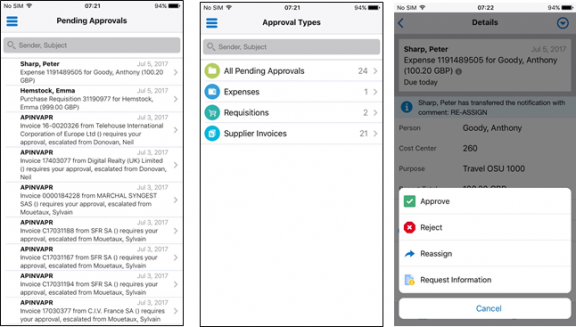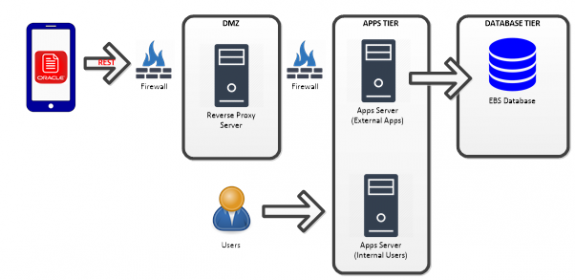Bringing The World Of E-Business Suite To Your Mobile
A small warning before we begin, this is not an article about a brand-spanking-new piece of Oracle technology that is about to change your world forever. This piece is about something that has been around for a while now but strangely seems to be under-used: E-Business Suite Mobile Applications.
These applications live on your phone or tablet and between them perform various business functions that you would otherwise have to log into E-Business Suite proper to perform such as approving someone’s expenses, raising a purchase order or entering your timesheet (I did mention this stuff isn’t earth-shattering remember).

A Suite Of Apps On The Go
I have worked with Oracle ERP applications since the mid-1990s and the take-up of the mobile application suite has never been huge. Which means that a lot of people who pay Oracle a lot of money for the pleasure of using EBS are missing out on some really handy and time-saving applications.
The first thing to know about these applications is that they are free. To be accurate they are free if you already have an EBS license for the related back-end module e.g. if you are licensed for procurement apps you can download Mobile Procurement, Mobile Expenses is yours if you have a license for Internet Expenses. All you have to do is go to the iStore if you have an Apple device or the Play Store if you run Android and search for ‘Oracle America Inc.’.
The list of applications you will find includes:
- Oracle Mobile Approvals for Oracle E-Business Suite
- Oracle Mobile Maintenance for Oracle E-Business Suite
- Oracle Fusion Expenses (originally developed for the Fusion Applications, but runs on E-Business Suite)
- Oracle Mobile Timecards
- Oracle Mobile Self-Service HR
- Oracle Mobile Field Service
- And many others….
For the full current list of available apps and links to the documentation have a look at note 1641772.1 on support.oracle.com.
So Why Use The Apps?
The benefit of these things is that they provide the key functional aspects for EBS, which is to say that they don’t try to replicate an entire module’s worth of features in the mobile apps.
With a typical phone screen measuring about 6cm by 10cm, Oracle has had to be pretty sparing with the features they included in the mobile apps to provide you with enough to make the apps useful without overcrowding the space and putting users off. And in most cases, Oracle has succeeded.
Below you can see screenshots from one of the most commonly used apps: Mobile Approvals.

There is enough information on the main list of approvals for the user to see what it is they are being asked to approve and then more details are available when you drill into the record (far-right image above) where approval or rejection is then a simple button press. The data displayed in the apps is generally enough to enable you to perform the task at hand and not more than that. If you are performing these types of tasks on your phone, then over-information is the last thing you need.
The great thing about mobile approvals is that it works across all the modules. Anything which is using Workflow to create approvals will be able to use mobile approvals. This also includes the option to build your own custom approval workflows and register these within Oracle Applications Manager (have a look under the System Administrator’s menu) and have these appear on the mobile app.
A very useful design feature on the apps is user authentication. When the user opens the app, they have to sign in using their normal EBS username and password. This means that the app is effectively acting as an extension to the main application and all features such as user security, responsibility access, track who created and updated records is all still in place. This also means users don’t need to memorise another password.
One ‘feature’ of the user authentication worth knowing about; once you sign into the app on your phone it will remember your username and won’t let you change it. The only way to sign on as a different user is to re-install the app. In the vast majority of cases, this won’t cause a problem because you don’t generally share your phone around with other users. I have found it a bit of a pain when you’re testing an app roll-out, however. Especially when you want to submit expenses as one user and then log on as the approver for example. In the grand scheme, this is a minor irritant.
The apps are built to have access to your device’s features such as camera, calendar and GPS, if they exist, and will detect if they don’t and disable the related features. For example, you can use your phone camera to take a picture of a receipt and attach this to your expenses claim in Oracle Fusion Expenses. The useful thing about the attachments is that these are visible in Mobile Approvals as well as the main EBS applications, Internet Expenses in this case.
Other handy device integration features include linking expense items to your phone’s calendar (very handy for linking meal receipts to business lunches).
Architecture
Most organisations like to keep their ERP applications nicely secured behind firewalls and given the type of data they contain, this is entirely understandable. And here we come to one of the major challenges of deploying mobile ERP applications, they need access to your ERP data in order to function properly. I suspect this reason has caused more than a few implementations to stall. Fortunately, there are some tried and tested ways to securely connect your mobile applications to your ERP applications. The example shown below is one that Claremont has implemented for one of our customers who implemented mobile procurement and approval applications.

In this example the ERP services required by the mobile apps are exposed to the outside world as REST services via a reverse proxy server. The app never connects directly to the EBS application server and in this way the integrity and security of the main application is maintained.
This example is useful for organisations where users need to wander away from the company’s premises to use their applications. Another of Claremont’s clients wanted to use the Mobile Supply Chain Applications, but within their own warehouse. In this case the apps could communicate via the site’s own Wi-Fi network and no external connectivity was required.
One other option, used by myself and my colleagues to demonstrate mobile applications to customers, is to install a VPN application onto the phone and use this to secure the communication channel. This method is the easiest to implement if you already have users remotely accessing your network from their laptops as it means the VPN connectivity is already in place.
Another route is via trusted certificates (e.g. from GlobalSign) which allows your apps to make secure links to the back-end. Once this route is set up it make the whole process of signing-in really straightforward (you just need your Oracle login and away you go), but there is more work to do at the infrastructure and network levels to set this up.
It’s worth noting that setting up the architecture is the most complex part of using these applications. Once you have connectivity you download your chosen app from the iStore or Google Play and off you go. You will need the usual URL of your E-Business instance and your EBS username and password. There are training guides available for the apps, but mostly they are easy enough to work out on your own (especially if you’re familiar with how the main application behind it works).
Once your architecture is in place just visit the Mobile Applications Administrator responsibility to make sure your chosen mobile apps are enabled from the back-end. The Oracle E-Business Suite Mobile Apps Administrator's Guide, Release 12.1 and 12.2 is your friend here.
Build Your Own Apps

Oracle’s mobile applications have, since 2014, been developed under the Mobile Applications Framework (MAF). The MAF framework is also available for customers to develop their own mobile applications in the event that one of the standard applications doesn’t deliver the functions you need. I’ve developed a few apps using MAF and the pleasing this about it is it’s really not that difficult to get started with.
There are some useful tutorials available on OTN (Oracle Technology Network) to get you started. You can run your apps in Android or iOS emulators running on your PC for testing. OAF has its limits so for the more technically gifted amongst you there is also Oracle JET (JavaScript Extension Toolkit). Claremont’s partner organisation Kogitas has developed applications using JET.
This article doesn’t set out to cover custom app development in any detail so please get in touch if you’d like more information on this route.
Leaving the custom application option aside the standard mobile apps are relatively easy to implement. Like I mentioned, your greatest challenge is likely to be setting up the required connectivity through your own network. If your team has a good understanding of the main applications behind the mobile apps then you’re already in a good place and adopting these apps won’t pose a significant challenge.
If you’d like to see them in action before taking the idea forward then get in touch with Claremont and we can arrange a demonstration for you.
Choosing the right Managed Services Provider
If you are looking for an Oracle partner who can help you with your Oracle Managed Services and goes about it the right way and can back up the talk, then contact us. If you would like to find out more about Mobile Applications or have a question, you can email us at info@claremont.co.uk or phone us on +44 (0) 1483 549004


